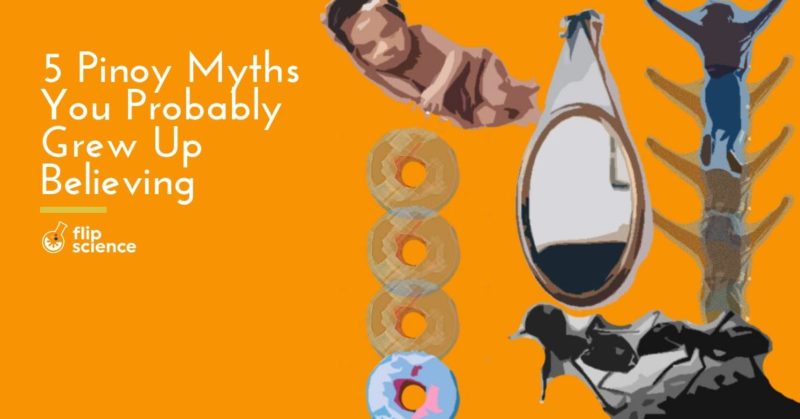• Superstitions and myths abound in Filipino culture, and rarely with any basis in scientific fact.
• These beliefs are meant to explain phenomena or warn against undesirable practices.
• Many of these are treated as conventional wisdom, passed on from generation to generation regardless of veracity.
Humans are curious by nature, which explains our penchant for coming up with explanations and figuring out how things work. Filipinos in particular exhibit this characteristic, with a dash of creativity thrown in for good measure. And while this enables us to come up with some truly impressive ideas, it also means that sometimes, scientific veracity gets sacrificed in favor of an amusing, if inaccurate, story.
Unfortunately, this becomes a problem when we start taking credit for things we shouldn’t and spouting pseudoscientific practices as if they were actual fact.
Here are five of the most common Pinoy myths, all of which you’ve probably heard from your friends, parents, or other relatives at some point.
Myth #1: “Wala pang 5 seconds!”
If you’ve ever dropped a piece of food on the floor or your table, chances are you went ahead and picked it up as if nothing happened, saying something along the lines of “Wala pang five seconds!” (“Five seconds haven’t passed yet!””)
This is one of those trickier myths to debunk, simply because conflicting research about it exists. Some researchers have said that this practice is perfectly safe, and that contamination does depend on the amount of time a substance spends exposed or in contact with potential contaminants. On the other hand, recent research reveals that this practice isn’t as soon as we’ve been led to believe, and that following the 5-second rule may actually put your health at risk.
It’s best to stay on the safe side, though, so forget the piece of bread you dropped and just get a new one.
Myth #2: “Baka mausog!”
The concept of “usog” is a rather odd one. A visitor or stranger with an “evil eye” may bring pain and discomfort to a baby with even just a verbal greeting, and the only way to protect the child is to break the curse by telling the stranger to say “Pwera usog,” making them lick their thumb, and tracing a cross on the infant’s forehead with saliva.
Unsurprisingly, not a shred of scientific evidence exists to prove this claim.
Myth #3: “Tumalon ka sa New Year para tumangkad ka!”
Simply put, as soon as the clock strikes 12 on January 1, the vertically challenged person should jump up and down in order to get taller over the course of the next year. It’s a New Year’s Day tradition that is perhaps as famous and persistent as the “our house must be decorated with round objects on New Year’s Eve” superstition.
Unfortunately, since one’s height heavily relies on just two things (genetics and nutrition), it is highly unlikely that any New Year’s skipping would give you that height boost you wanted.
Myth #4: “Pampaganda ng boses ang langgam!”
We’re not quite sure where or how this bizarre story started. Basically, it involves straight-up drinking or eating any ants you find swimming in your coffee or crawling on your plate. Unfortunately, there’s no scientific evidence whatsoever that eating ants will help you hit those high notes.
However, this story’s probably just the brainchild of someone who, long ago, felt too lazy to just pick the poor insects out of their food with a fork.
Myth #5: “Kapag nabasag mo ‘yang salamin, pitong taon kang mamalasin!”
Depending on who you ask, the “7 years of bad luck” mirror myth may have originated from one of two countries.
Some say that in ancient Rome, they believed that it took a seven-year cycle for life to renew itself. They also believed that a sick person looking into a mirror will probably break it. Once this happens, that person will need to wait seven years for the “bad luck” to wear off.
Meanwhile, others believe that the Greeks, particularly the myth of Narcissus, were the origin of this baffling belief.
Either way, the story may probably a scare tactic from mirror vendors to prevent clumsy customers from touching their wares and potentially breaking them.
Reference
- https://timesofindia.indiatimes.com/life-style/health-fitness/health-news/the-5-second-rule-is-not-as-safe-as-you-think/articleshow/66607074.cms
- http://www.mirrorhistory.com/mirror-facts/broken-mirror/
- https://www.britannica.com/topic/Narcissus-Greek-mythology
- https://www.gmanetwork.com/news/scitech/science/352405/pwede-pa-yan-wala-pang-5-seconds-is-scientifically-true-sort-of/story/
- https://www.prevention.com/food-nutrition/a24787763/five-second-rule/
- https://www.scientificamerican.com/article/how-much-of-human-height/
- https://www.smartparenting.com.ph/parenting/baby/is-usog-for-real.
Author: Mikael Angelo Francisco
Bitten by the science writing bug, Mikael has years of writing and editorial experience under his belt. As the editor-in-chief of FlipScience, Mikael has sworn to help make science more fun and interesting for geeky readers and casual audiences alike.







